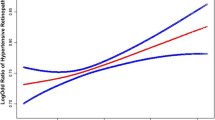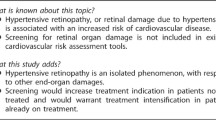Abstract
Objective
Microalbuminuria is an important marker of end organ damage in hypertensive patients, but is often not tested for, especially in a resource-poor setting. We studied the accuracy of retinal changes in predicting microalbuminuria among a cohort of geriatric hypertensive patients.
Methods
One hundred and eighty elderly hypertensive patients aged more than 65 years were assessed for their demographic characteristics, smoking status, duration of hypertension, current severity of hypertension, body mass index, left ventricular hypertrophy by electrocardiogram (ECG), and high sensitivity C-reactive protein (HsCRP). Optic fundi were assessed for retinopathy after pupillary dilatation, and were photographed. Microalbuminuria (albumin–creatinine ratio) was measured as an average of two nonconsecutive overnight spot urine samples. Patients with pre-diabetes, diabetes, metabolic syndrome, treatment with angiotensin converting enzyme inhibitors and/or angiotensin receptor blockers, overt nephropathy or proteinuria, and active infection were excluded.
Results
Mean age was 74 ± 6.56 years. One-third were obese and 18.9% had left ventricular hypertrophy. Prevalence of microalbuminuria was 39.4% and prevalence of retinopathy was 40%. Microalbuminuria showed a strong association with retinopathy (P < 0.0001). Logistic regression identified association of microalbuminuria with duration of hypertension (P = 0.001) and elevated high sensitivity C-reactive protein (P = 0.021). Retinopathy was associated with duration of hypertension (P = 0.001) and smoking (P < 0.0001). Tests of accuracy for retinopathy as a predictor of microalbuminuria showed a sensitivity of 72% and specificity of 81%.
Conclusion
Prevalence of microalbuminuria and retinopathy were quite high in our cohort of elderly hypertensive patients. Retinal changes of any grade probably have moderate accuracy in predicting microalbuminuria and hence we can initiate work-up for target organ damage, especially in a resource-poor setting.
Similar content being viewed by others
References
Kearney PM, Whelton M, Reynolds K, Muntner P, Whelton PK, He J (2005) Global burden of hypertension: analysis of worldwide data. Lancet 365:217–223
Blythe WD, Maddux FW (1991) Hypertension as a causative diagnosis of patients entering end-stage renal disease programs in the United States from 1980–1986. Am J Kidney Dis 28:33–37
Wesstuch JM, Dworkin LD (1992) Does essential hypertension cause end-stage renal disease? Kidney Int 41(Suppl 36):S33–S37
Rutkowski B (2000) Changing pattern of end-stage renal disease in central and eastern Europe. Nephrol Dial Transplant 15:156–160. doi:10.1093/ndt/15.2.156
Mani MK (2003) Prevention of chronic renal failure at the community level. Kidney Int 63(Suppl 83):S86–S89. doi:10.1046/j.1523-1755.63.s83.17.x
Prakash J, Hota JK, Singh S, Sharma OP (2006) Clinical spectrum of chronic renal failure in the elderly: a hospital based study from eastern India. Int Urol Nephrol 38(3–4):821–827. doi:10.1007/s11255-006-9003-y
Prakash J, Saxena RK, Sharma OP, Usha (2001) Spectrum of renal diseases in the elderly: single center experience from a developing country. Int Urol Nephrol 33(2):227–233. doi:10.1023/A:1015279619491
Tiwari SC, Srivastava S (1998) Geropsychiatric morbidity in rural Uttar Pradesh. Indian J Psychiatry 40:266–273
Ministry of health and family welfare, government of India (2002) Annual report: health plan and policy. Ministry of health and family Welfare, New Delhi, p 15
Mohan V, Deepa M, Farooq S, Datta M, Deepa R (2007) Prevalence, awareness and control of hypertension in Chennai—the Chennai urban rural epidemiology study (CURES-52). JAPI 55:326–332
Yudkin JS, Forrest RD, Jackson C (1988) Microalbuminuria as predictor of vascular disease in nondiabetic subjects. Lancet 2:530–533. doi:10.1016/S0140-6736(88)92657-8
Damsgaard EM, Froland A, Jorgensen OD, Mogensen CE (1990) Microalbuminuria as predictor of increased mortality in elderly people. BMJ 300:297–300
Marcia G, De Backer G, Dominiczak A, Cifkova R, Fagard R, Germano G et al (2007) 2007 Guidelines for the management of arterial hypertension. Eur Heart J 28:1462–1536
Positional statement, American Diabetes Association (2006) Diagnosis and classification of diabetes mellitus. Diabetes Care 29:S43–S48
Executive summary of the third report of the national cholesterol education program (NCEP) expert panel (2001) on detection, evaluation and treatment of high blood cholesterol in adults (adult treatment panel III) JAMA 285:2486–2497
Chobanian AV, Bakris GL, Black HR, Cushman WC, Green LA, Izzo JL et al (2003) The seventh report of the joint national committee on prevention, detection, evaluation and treatment of high blood pressure (JNC-7). JAMA 289:2560–2571. doi:10.1001/jama.289.19.2560
Jeffrey SF, Eleftheria MF (2005) Obesity. In: Kasper DL, Braunwald E, Fauci AS, Hauser SL, Longo DL, Jameson JL (eds) Harrison’s principles of internal medicine, vol 1, 16th edn. McGraw Hill Inc, New York, pp 422–423
Poulsen PL, Mogensen C (1998) Clinical evaluation of a test for immediate and quantitative determination of urinary albumin to creatinine ratio. Diabetes Care 21:97–98
Hoy W, SP McDonald (2004) Albuminuria: marker or target in indigenous populations. Kidney Int 66(Suppl 92):S25–S31. doi:10.1111/j.1523-1755.2004.09207.x
Tetsuya B, Chieko T, Yasuhiko I (2004) Definition of microalbuminuria in first-morning and random spot urine in diabetic patients. Diabetes Care 27:1838–1839. doi:10.2337/diacare.27.7.1838
Keith NM, Wagner HP, Barker NW (1939) Some different types of essential hypertension—their course and prognosis. Am J Med Soc 197:332–343
Romhilt DW, Estes EH Jr (1968) A point-score system for the ECG diagnosis of left ventricular hypertrophy. Am Heart J 75:752–758. doi:10.1016/0002-8703(68)90035-5
Greenberg RS, Daniels SR, Dana Flanders W, Eley JW, Boring JR (2005) Diagnostic testing. In: Greenberg RS (ed) Medical epidemiology. McGraw-Hill, New York
Cuspidi C, Salerno M, Salerno DE, Meani S, Valerio C, Esposito A et al (2004) High prevalence of retinal vascular changes in never-treated essential hypertensives: an inter- and intra-observer reproducibility study with non-mydriatic retinography. Blood Press 13(1):25–30. doi:10.1080/08037050310025753
Cuspidi C, Macca G, Salerno M, Michev L, Fusi V, Severgnini B et al (2001) Evaluation of target organ damage in arterial hypertension: which role for qualitative funduscopic examination? Ital Heart J 2(9):702–706
Ruilope LM, Salvetti A, Jamerson K, Hansson L, Warnold I, Wedel H et al (2001) Renal function and intensive lowering of blood pressure in hypertensive participants of the hypertension optimal treatment (HOT) study. J Am Soc Nephrol 12:218–225
Mann JF, Gerstein HC, Pogue J, Bosch J, Yusuf S (2001) Renal insufficiency as a predictor of cardiovascular outcomes and the impact of ramipril: the HOPE randomized trial. Ann Intern Med 134:629–636
Pontremoli R, Sofia A, Ravera M, Nicolella C, Viazzi F, Tirotta A et al (1997) Prevalence and clinical correlates of microalbuminuria in essential hypertension. The MAGIC study. Hypertension 30:1135–1143
Hoegholm A, Bang LE, Kristensen KS, Nielsen JW, Holm J (1994) Microalbuminuria in 411 untreated individuals with established hypertension, white coat hypertension, and normotension. Hypertension 24:101–105
Redon J, Rovira E, Miralles A, Julve R, Pascual JM (2002) Factors related to the occurrence of microalbuminuria during antihypertensive treatment in essential hypertension. Hypertension 39:794–798. doi:10.1161/hy0302.105209
Jager A, Kostense PJ, Ruhé HG, Heine RJ, Nijpels G (1999) Microalbuminuria and peripheral arterial disease are independent predictors of cardiovascular and all-cause mortality, especially among hypertensive subjects: five-year follow-up of the Hoorn Study. Arterioscler Thromb Vasc Biol 19:617–624
Levy BI, Ambrosio G, Pries AR, Struijker-Boudier HAJ (2001) Microcirculation in hypertension—a new target for treatment? Circulation 104:735–740. doi:10.1161/hc3101.091158
Agewall S, Wikstrand J, Ljungman S, Fagerberg B (1997) Usefulness of microalbuminuria in predicting cardiovascular mortality in treated hypertensive men with and without diabetes mellitus. Risk factor intervention study group. Am J Cardiol 80:164–169. doi:10.1016/S0002-9149(97)00312-3
Ljungman S, Wikstrand J, Hartford M, Berglund G (1996) Urinary albumin excretion—a predictor of risk of cardiovascular disease. A prospective 10-year follow-up of middle-aged nondiabetic normal and hypertensive men. Am J Hypertens 9:770–778. doi:10.1016/0895-7061(96)00102-1
Redon J, Liao Y, Lozano JV et al (1994) Factors related to the presence of microalbuminuria in essential hypertension. Am J Hypertens 7:801–807
Culleton BF, Larson MG, Wilson PW, Evans JC, Parfrey PS, Levy D (1999) Cardiovascular disease and mortality in a community-based cohort with mild renal insufficiency. Kidney Int 56:2214–2219. doi:10.1046/j.1523-1755.1999.00773.x
Kronenberg F, Kuen E, Ritz E, Junker R, Konig P, Kraatz G et al (2000) Lipoprotein (a) serum concentrations and apolipoprotein (a) phenotypes in mild and moderate renal failure. J Am Soc Nephrol 11:105–115
Fliser D, Pacini G, Engelleiter R, Kautzky-Willer A, Prager R, Franek E et al (1998) Insulin resistance and hyperinsulinemia are already present in patients with incipient renal disease. Kidney Int 53:1343–1347. doi:10.1046/j.1523-1755.1998.00898.x
Jungers P, Joly D, Massy Z, Chauveau P, Nguyen AT, Aupetit J et al (1999) Sustained reduction of hyperhomocysteinaemia with folic acid supplementation in predialysis patients. Nephrol Dial Transplant 14:2903–2906. doi:10.1093/ndt/14.12.2903
Tsioufis C, Dimitriadis K, Taxiarchou E, Vasiliadou C, Chartzoulakis G, Tousoulis D et al (2006) Diverse associations of microalbuminuria with C-reactive protein, interleukin-18 and soluble CD40 ligand in male essential hypertensive subjects. Am J Hypertens 19:462–466. doi:10.1016/j.amjhyper.2005.07.026
Lydakis C, Lip GYH (1998) Microalbuminuria and cardiovascular risk. Q J Med 91:381–391
van den Born B-JH, Hulsman CAA, Hoekstra JBL, Schlingemann RO, van Montfrans GA (2005) Value of routine funduscopy in patients with hypertension: systematic review. BMJ 331:73–77
Cuspidi C, Meani S, Valerio C, Fusi V, Catini E, Sala C et al (2005) Prevalence and correlates of advanced retinopathy in a large selected hypertensive population. The evaluation of target organ damage in hypertension (ETODH) study. Blood Press 14(1):25–31. doi:10.1080/08037050510008805
Ebinc H, Ebinc FA, Ozkurt ZN (2007) Relationship of early hypertensive retinopathy to inflammation markers and microalbuminuria in hypertensive patients with regulated blood pressure. Saudi Med J 28(3):472–473
Cuspidi C, Meani S, Salerno M et al (2004) Retinal microvascular changes and target organ damage in untreated essential hypertensives. J Hypertens 22:2095–2102. doi:10.1097/00004872-200411000-00010
Saitoh M, Matsuo K, Nomoto S, Kondoh T, Yanagawa T, Katoh Y et al (1998) Relationship between left ventricular hypertrophy and renal and retinal damage in untreated patients with essential hypertension. Intern Med 37:576–580. doi:10.2169/internalmedicine.37.576
Cerasola G, Cottone S, D’Ignoto G, Grasso L, Mangano MT, Carapelle E et al (1989) Microalbuminuria as a predictor of cardiovascular damage in essential hypertension. J Hypertens 7(Suppl 6):S332–S333
Pontremoli R, Cheli V, Sofia A, Tirotta A, Ravera M, Nicolella C et al (1995) Prevalence of micro- and macroalbuminuria and their relationship with other cardiovascular risk factors in essential hypertension. Nephrol Dial Transplant 10(Suppl 6):6–9
Kozan O, Buyukoz turk K, Ilerigelen B, Kabakci G, Koylan N et al (2007) The impact of plasma high-sensitivity C-reactive protein levels on cardiovascular risk stratification of hypertensive patients: results of the ICEBERG study. J Clin Hypertens 9(7):500–505. doi:10.1111/j.1524-6175.2007.05738.x
Bakris GL, Ruilope L, Locatelli F, Ptaszynska A, Pieske B, de Champlain J et al (2007) Treatment of microalbuminuria in hypertensive subjects with elevated cardiovascular risk: results of the IMPROVE trial. Kidney Int 72(7):879–885. doi:10.1038/sj.ki.5002455
Skov K, Fenger-Gron J, Mulvany MJ (1996) Effects of an angiotensin converting enzyme inhibitor, a calcium antagonist, and an endothelin receptor antagonist on renal afferent arteriolar structure. Hypertension 28:464–471
Puttinger H, Soleiman A, Oberbauer R (2003) Regression of hypertensive nephropathy during three years of optimal blood pressure control. Wien Klin Wochenschr 115(12):429–431
Leatham A et al (1949) The retinal vessels in hypertension. QJM 18:203–204
Author information
Authors and Affiliations
Corresponding author
Rights and permissions
About this article
Cite this article
Shantha, G.P.S., Bhaskar, E., Kumar, A.A. et al. Accuracy of retinal changes in predicting microalbuminuria among elderly hypertensive patients: a cross-sectional study from a teaching hospital in South India. Int Urol Nephrol 41, 137–143 (2009). https://doi.org/10.1007/s11255-008-9452-6
Received:
Accepted:
Published:
Issue Date:
DOI: https://doi.org/10.1007/s11255-008-9452-6




